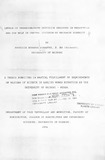| dc.description.abstract | The levels of organochlorine pesticide residues were
determined by gas chromatography in 147· human milk and 21
pooled cow milk samples, collected from two different agroecological
zones of central division of Machakos, Kenya. The
human milk samples were from mothers who had lived in the
study area for over 5 years, were healthy and at the time
breast feeding first or second child. The milk samples were
collected at 1 week to 4 months postpartum.
A total of 23 pesticide residues were detected in breastmilk,
while 17 pesticide residues were detected in cow milk. The
main organochlorine contaminants in human milk and cow milk
were the DDT group, heptachlor/heptachlor epoxide and the
HCH group at frequericies of 97%, 66%, 23% in breastmilk and
100%, 71%, 46% in cow milk, respectively.
There was a higher prevalence of the pesticide residues in
the high potential production zone as compared to the low
potential production zone. Significantly (p<0.05) higher
levels of ~-HCH and t-HCH in breastmilk and p,p'- DDD in cow
milk were found in the low than in the high potential
production zone.
In breastmilk, significantly higher levels of sum DDT and aendosulfan
were found in cases where pesticides were used in
households as compared to cases where no use was reported.
Levels of oxychlordane and a- endosulfan were lower in areas
where pesticides were reportedly used on crops in the farms
as compared to areas where no use was reported. Finally,
lower levels of a-endosulfan were found in cases where cash
crops were grown compared to areas where subsistence crops
were grown while incidences were higher in the high potential
production zone.
The mean levels of endrin and chlordane in human milk and
chlordane in cow milk were above the prescribed codex
alimentarius maximum residue limit (MRL) for milk and milk
products.
The calculated daily intake by suckling infants in the study
area of heptachlor epoxide, endrin, oxychlordane, endosulfan,
chlordane and lindane from human milk exceeded the WHO/FAa
acceptable daily intakes (ADI) by 70, 40, 9, 6.3, 4 and 1.6
times respectively. For cow milk on the other hand,
calculated daily intakes by infants of heptachlor epoxide,
oxychlordane, chlordane and endosulfan exceeded the ADI
values by 30, 6, 5 and 1.5 respectively.
In summary, organochlorines had been used in the study area
to the extend that consumption of human and cow milk by
infants exposed them to risky levels of especially heptachlor
epoxide, endrin, oxychlordane, endosulfan, chlordane, and
lindane.
Monitoring programmes should be initiated to ensure that all
avenues of exposure are documented and ways of reducing the
environmental contamination by pesticide residues are
developed and implemented. | en |

